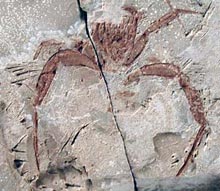Dinosaur, crab fossils reveal ecosystem secrets

This well-preserved fossil of a crab was found within inches of a dinosaur tail in Egypt’s Bahariya Oasis, the first evidence in literature of the two found together. The find helps piece together what ancient envrionments might have been like
For centuries, they wouldn’t be caught dead next to each other.
But now a team of geologists directed by Joshua Smith, Ph.D., assistant professor of earth and planetary sciences at Washington University in St. Louis, have found a well-preserved fossil of a crab within inches of a tail vertebra from a massive plant-eating dinosaur.
This well-preserved fossil of a crab was found within inches of a dinosaur tail in Egypt’s Bahariya Oasis, the first evidence in literature of the two found together. The find helps piece together what ancient envrionments might have been like.
The find, in Egypt’s Bahariya Oasis, is the first instance of a crab fossil found with a dinosaur fossil. It reveals much about both species and the kind of ecosystem where the fossils were found, thought to be a predator-rich mangrove setting dominated by tree ferns and other coastal plants, similar to Florida’s swampy Everglades. The rocks containing these fossils are about 94 million years old, which means they date back to the Cretaceous Period, which lasted from 130-65 million years.
“The two normally don’t hang with each other, or they are at least not commonly discovered together,” said Smith, of crabs and dinosaurs. Smith made international news in 2001 when he and collaborators published results of their discovery of the second most massive dinosaur ever unearthed, Paralititan stromeri, in the same part of the Bahariya Oasis. “There have been anecdotal mentions of crabs with dinosaurs, but those remains turned out to be lobsters or ghost shrimp. Even if the time gap between the two is thousands of years, we have visual proof of these two coexisting together. This is a nice surprise. It fills in more about this kind of ecosystem.”
The results are in a paper that will be published later this year in the Journal of Paleontology.
Smith and collaborators from the University of Pennsylvania, the Cairo Geological Museum, and Drexel University discovered the fossils in 2001, on an expedition for dinosaur bones. They found a dinosaur tailbone, fossil plants and the crab, all within a foot-and-a-half of each other. Because there have been informal (though never published in peer-review journals) mentions of crabs being part of ecosystems where dinosaur bones have been found, and more importantly because he isn’t qualified to describe a crab, Smith wanted to clarify and sought geologist Carrie E. Schweitzer, Ph.D., of the Kent State University Department of Geology.
“As far as we can tell from the literature, this is the first confirmed notice of a crab associated with a dinosaur,” said Schweitzer, who is the lead author on the crab paper. “The find is significant because it permits paleontologists to frame a very diverse — and thus much more accurate — description of what these ancient environments would have looked like.
“The deposits that enclose the dinosaur and the crab also contain crocodile-like animals, various invertebrates, fish, sharks, plesiosaurs, a kind of reptile, and turtles as well as plant material. Thus, we have a very complete idea of what types of organisms comprised the ecosystem.”
Crabs, “brachyuran decapods” in technical jargon, from coastal habitats are uncommon in the fossil record because their remains rapidly disintegrate, either from decomposition or scavenging by other predators. The geologists think that the crabs of the Bahariya Formation probably were scavengers that fed on vegetation and other organic material. They were a possible food source for fish and other vertebrates and invertebrates in the ecosystem.
Smith speculates that it is possible that small or baby dinosaurs might have fed on the crabs, but said speculation is the most he can do.
“This would have been a very productive place biologically, for crabs, they would have been very happy here,” Smith said. “Almost everything we’re finding at the site is a predator. I could see a baby Spinosaurus picking up mangrove crabs, but it’s all speculation because we have no solid proof of what dinosaurs ate.”
Media Contact
All latest news from the category: Earth Sciences
Earth Sciences (also referred to as Geosciences), which deals with basic issues surrounding our planet, plays a vital role in the area of energy and raw materials supply.
Earth Sciences comprises subjects such as geology, geography, geological informatics, paleontology, mineralogy, petrography, crystallography, geophysics, geodesy, glaciology, cartography, photogrammetry, meteorology and seismology, early-warning systems, earthquake research and polar research.
Newest articles

First-of-its-kind study uses remote sensing to monitor plastic debris in rivers and lakes
Remote sensing creates a cost-effective solution to monitoring plastic pollution. A first-of-its-kind study from researchers at the University of Minnesota Twin Cities shows how remote sensing can help monitor and…

Laser-based artificial neuron mimics nerve cell functions at lightning speed
With a processing speed a billion times faster than nature, chip-based laser neuron could help advance AI tasks such as pattern recognition and sequence prediction. Researchers have developed a laser-based…

Optimising the processing of plastic waste
Just one look in the yellow bin reveals a colourful jumble of different types of plastic. However, the purer and more uniform plastic waste is, the easier it is to…



